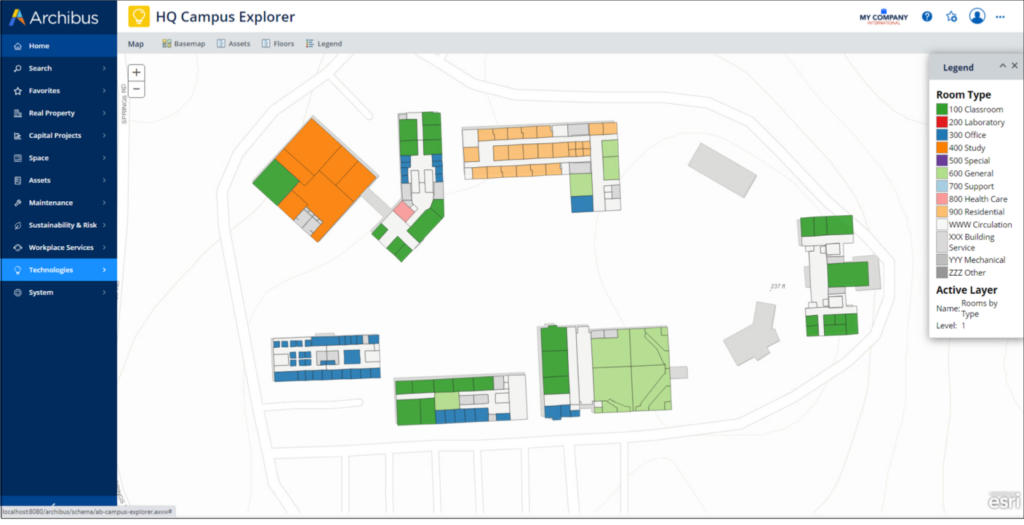Now, perhaps more than ever, employers are seeking to enhance their approach to the workplace experience. They are embracing new trends, such as hybrid structures and smart buildings, to create what we like to call “digital workplace euphoria.”
Euphoria may seem like hyperbole, but happy employees make for successful businesses. We’re not talking about amenities like ping pong tables, free Friday lunches, and in-office theaters. The goal of a euphoric workplace is to transform barely there connected offices to intelligent, autonomous ecosystems that empower employees to their most productive and efficient while maintaining healthy work-life balances.
Research indicates that we are seeing much more of a radical change among companies reacting to the workplace trends. Leaders in companies may not respond to every human or occupant need, but certainly, they are reacting to create a more automated workplace for agile teams. One part of the “why” for proactive movement toward hybrid agile is the long-term impact on business.
 Many companies are going through significant financial losses due to COVID-19. How companies navigate digital disruption will likely affect their revenues and future operations. During the crisis of the companies who saw a 25% growth in the revenues 72% were first to experiment with new technologies. As well, 67% of those companies invested more in digital-related expenditures, according to a 2020 report by McKinsey. The companies that had not taken steps are electing to embrace the productivity associated with remote work to help them recoup those costs of not doing so in the past.
Many companies are going through significant financial losses due to COVID-19. How companies navigate digital disruption will likely affect their revenues and future operations. During the crisis of the companies who saw a 25% growth in the revenues 72% were first to experiment with new technologies. As well, 67% of those companies invested more in digital-related expenditures, according to a 2020 report by McKinsey. The companies that had not taken steps are electing to embrace the productivity associated with remote work to help them recoup those costs of not doing so in the past.
Certain financial dependencies, like expiring office leases and stakeholder pressures, are pushing companies to make an immediate decision on how to proceed with digital based investments to create work environments conducive to agile work, from anywhere. According to a Gartner survey, 38% of tech, media, and telecom business leaders (and 26% of leaders across all represented industries) reported plans to reduce their real estate footprint by, for example, closing retail locations. Gartner also reported that 74% of CFOs and finance leaders at least 5% of their previously on-site workforce to permanently remote positions after COVID-19.
Why Companies Choose to Go Hybrid
Remote and hybrid work is not new, but it certainly hasn’t been as widespread as it is now. According to a Microsoft report, some professions have been trending toward remote work since the oil crisis of the 1970s that resulted in substantially higher commuting and automotive costs. In 2020, the COVID-19 pandemic drove a “profound increase in the magnitude and speed of the shift toward remote work, with 88% of organizations from around the world surveyed in March [2020] reporting that they were encouraging employees to work from home,” the report noted. More than a third of U.S. workers transitioned to remote or hybrid work between March and April 2020 alone.
Aside from the long-term impact on fiscal reports, this mass transition away from the confines of a 9-to-5 physical office is the other part of the “why” for companies looking to improve three key facets of the digital workplace: people, space, and technology.
The Workplace Mantra: People, Space, and Technology
Creating an environment for employees – or an investor’s case, tenants – that elicits a sense of euphoria is challenging but not impossible. How are companies tackling the digital workplace? There are three elements of an optimized workplace that one should consider.
The first starts with people. People form the community within an organization that will serve as the litmus test for successful digital workplace implementation.
The second element is technology, which acts as the catalyst for change and encompasses each tier of the Smart Building Maturity Model. Most buildings fall somewhere in between the connected and intelligent spaces of the model. From the Internet of Things (IoT) to artificial intelligence (AI), the infrastructure created by technology ultimately makes up the third element of an enhanced workplace: space.
Space doesn’t always refer to a physical location; it relates to the context in which people are working. Space can mean a geographically distributed footprint, flexible hoteling and co-working spaces within your organization, or a scalable real estate portfolio that allows you to set your physical and virtual space settings in a manner that best suits your internal method of operating.
Georgia-Pacific (GP) is one company that has fully embraced all three spheres of the optimized workplace, and by the way is one of the companies that experimented with digital based agile work long before the COVID-19 crisis. The Atlanta-based maker of paper, packaging, building products, and related chemicals resides in an iconic office tower. In the first major renovation since the company occupied the tower in 1982, GP aimed to achieve “optimal integration, functionality, cost and efficiency among the various systems throughout each floor – lighting, HVAC, audio-visual and room scheduling systems,” according to a company press release. The digital building transformation included an Internet of Things (IoT) foundation that resulted in economically feasible, purposeful automation carefully constructed for GP’s user base.
GP reported that the building uses “bio-dynamic (circadian) lighting in the office and collaboration areas, driven by network-connected lighting management. [GP] will respond to peak electrical demands by adjusting building systems. The interconnected system allows the company to collect accurate, real-time data to understand how the space is used, improve employee productivity and satisfaction, and increase real estate investment.”
Along with commercial offices, hospitality and education are two other industries that are exceptionally receptive to similar methods of in-house automation. Fortunately, platforms offered by companies like SpaceIQ offer businesses of all sizes and types of options to create digital workplaces that support agility and flexibility.
Hybrid Strategies for Working “Smart” and Hard
For many companies, leveraging hybrid strategies starts with creating smart buildings and workplaces.
Smart building(s) – both as a verb and a noun – is a partner of hybrid workplaces at the heart of the “next normal” regarding the future of work. Over the last year, companies worldwide have experienced a rapid shift to long-term hybrid and/or remote environments. From Human Resources (HR) to Information Technology (IT) to Marketing and beyond, the functional teams within these organizations are being driven to review their existing work practices and confirm that they align with employees’ current needs.
For some companies, this process may feel like an uncertain scramble – but it shouldn’t.
This moment presents an opportunity for organizations to revise their digital framework and create an even better workplace experience – one that encourages a positive return-to-office transition after a yearlong hiatus or, for remote and hybrid workers, a structure that compels them to engage virtually. Smart building is critical for both employees and executives to tap into the human side of work and reach peak satisfaction in the process of doing so.
As a company specializing in “smart building,” Cognitive Corp is at the forefront of researching and analyzing workplace trends and technologies that impact commercial real estate (CRE) teams.
So, what do we mean by “smart building?” In a word, automation.
Smart building implies that a company has a built-in infrastructure to automate as many day-to-day and long-term tasks as possible. Infrastructure can include IT and networks, HVAC, lighting, time-tracking, scheduling, and anything in between that has a digital footprint.
A key strategy is to distribute the levels of automation and smart building into four tiers on a visual pyramid called the Smart Building Maturity Model. This model helps companies prioritize based on current needs and future growth:
-
- Connected Building: Connected building forms the foundation at the bottom of the pyramid. Most companies fall into this category, which includes basic IT networks and the commonplace technology you’d find in a standard office.
- Intelligent Building: With system integration, energy efficiency, and building automation, intelligent building is what most companies strive for in their next-level smart building process. It can lead to more unified collaboration, better asset management, and streamlined workspace and remote services.
- Smart Building: The core of the pyramid. Smart building includes open architecture, occupant interaction predictive analytics, which contributes to human centric workplace metrics, on-demand services, big data, and more elements of building intelligence. The future of work is already here, and smart building should be a consideration for most companies.
- Cognitive Building: At the pinnacle of the pyramid we’ll find cognitive building. Here, machine learning, artificial intelligence (AI), and robotics are the vital pieces that drive building automation. While most non-technological companies do not aim for this high-level tier, we believe it’s still essential knowledge to know all the possibilities within the realm of intelligent architecture.
Data-driven Insights to Support the Hybrid Workplace
The digital workplace focuses on the occupant’s experience within a technological ecosystem. A successful digital workplace supports the human-centric side of corporate initiatives. Different personas within the commercial real estate industry will perform unique functions depending on their role in their organization. However, all roles utilize metrics to inform the progress of their digital transformation.
For individual roles, here are some items to consider:
-
- Commercial Real Estate and Facilities Managers: Individuals entrusted with managing facilities should articulate workplace values about the broader business. This includes adapting to change, especially as it relates to the physical space. Your growth mindset should shift from fixed to fluid.
- Workplace Professionals: As a workplace professional, try to develop strategies and tactics that support agile, flexible workplaces and employee experiences. Consider the wider range of knowledge available to you, beyond just “physical office” and “working from home.”
Workplace Euphoria is Frictionless
An agile, flexible workplace is no longer an option for most businesses; it is a requirement. Baseline metrics allow companies to see how initiatives eliminate employee and occupant stress during times of uncertainty, deliver on diversity, equity, and inclusion commitments, improve operational efficiency, and make remote work, workable.
Additionally, metrics shed light into the onboarding of new technologies, security automation, and workplace productivity. Workplace analytics provide a 360-degree view of any misaligned technology expectations. Embracing technology to create agility and flexibility in return to the workplace can result in euphoria for employers and employees.
To learn more request a demo.
About IMS Consulting
For more than a decade, IMS Consulting has delivered the full scope of ARCHIBUS-related services to both government and commercial clients. As a Virginia Certified Small Business, IMS Consulting provides our clients with personalized attention by experienced ARCHIBUS certified consultants. Our experts work with our clients to thoroughly understand how they do business, identify their unique needs, and pinpoint opportunities to better manage their infrastructure, employ more efficient work processes, and make smarter capital budgeting decisions—both today and over the long term.
IMS Consulting specializes in the implementation of ARCHIBUS, the #1 real estate, infrastructure & facilities management solution in the world. ARCHIBUS is the global leader in streamlining how you manage your real estate, infrastructure, and facilities. Centralize your data, planning, and operations onto one seamless platform backed by 35 years of innovation and the world’s largest support network. Reduce costs, enhance sustainability, and create a better workplace by transforming how you connect with people, places, and processes.
 Use Cases: Several practical applications highlight the value of integrating Esri with Archibus:
Use Cases: Several practical applications highlight the value of integrating Esri with Archibus:


 Implementing Archibus Analytics for Operational Excellence
Implementing Archibus Analytics for Operational Excellence Many companies are going through significant financial losses due to COVID-19. How companies navigate digital disruption will likely affect their revenues and future operations. During the crisis of the companies who saw a 25% growth in the revenues 72% were first to experiment with new technologies. As well, 67% of those companies invested more in digital-related expenditures, according to a 2020 report by McKinsey. The companies that had not taken steps are electing to embrace the productivity associated with remote work to help them recoup those costs of not doing so in the past.
Many companies are going through significant financial losses due to COVID-19. How companies navigate digital disruption will likely affect their revenues and future operations. During the crisis of the companies who saw a 25% growth in the revenues 72% were first to experiment with new technologies. As well, 67% of those companies invested more in digital-related expenditures, according to a 2020 report by McKinsey. The companies that had not taken steps are electing to embrace the productivity associated with remote work to help them recoup those costs of not doing so in the past.